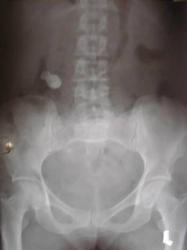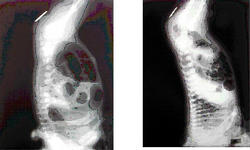Plain abdominal X-ray
Home Page
Plain abdominal X-ray
Barium Swallow
Breast Imaging
Chest X-ray
Answer of MCQ Exam, 30.10.2007
Principles of diagnostic radiology
IMAGING OF THE BILIARY TRACT
IMAGING OF THE BILIARY TRACT
Photo Page 3
Catalog Page
About
1. Small Intestinal Obstruction
Plain abdominal film shows multiple air-fluid level.A. Causes:
2. LARGE BOWEL OBSTRUCTION
A. Causes:
1.Colorectal cancer.
2.Inflammatory bowel diseases,
3.Adhesive bands,
4.Volvulus,
5.Diverticulitis
6.Fecal impaction.
7. Hernia
B. Radiological Findings
nIn plain abdominal film, the distended colon creates a “picture-frame” outline of the abdominal cavity.
nIn late cases, radiological findings of both small and large bowel become evident i.e. multiple air-fluid levels with gas distension of the colon.
3. VOLVULUS OF THE SIGMOID
3. Volvulus of the Sigmoid Colon
Radiological Findings
- On a plain film of the abdomen, a single, greatly distended loop of bowel that has lost its haustral markings is usually seen rising up out of the pelvis, frequently as high ads the diaphragm.
- The distended loop may assume a “coffee-bean” shape. It points towards the left lower quadrant
4. Free Intraperitoneal Gas (Pneumoperitoneum)

A. Causes of free intraperitoneal gas
1.Early postoperative (3-5 days).
2.Perforated peptic ulcer
3.Perforated colonic diverticulum.
4.Post-traumatic.
5.Perforated appendix and small intestine rarely cause detectable free intraperitoneal gas.
B. Radiological Findings
- In erect position, intraperitoneal gas will be seen under both leaves of the diaphragm.
- In left decubitus film, air is found over the dome of the liver.
5. Air Contained within an Abscess Cavity
A plain chest or abdominal film in patients with subphrenic abscess may show one or more of the following:
- –Raised hemidiaphragm.
- –Basal lung pneumonia.
- –Pleural effusion.
- –Decreased diaphragmatic movement.
- –Mottled bubbly appearance.
- –Abnormal gas and air-fluid level.
6. Abnormal Extra-skeletal Calcifications
Causes of extra-skeletal calcification
1.Rib cartilages.
2.Vessels:
a)Calcified aortic, iliac or splenic aneurysms.b)Phlebolith.
3.Genitourinary calculi
4.Gall stones (10-15% of gall stones are radio-opaque)
5.Pancreatic calcifications or stone as in chronic pancreatitis.
6.Mesenteric lymph nodes (e.g. tabes mesenterica)
7.Dermoid cysts.
8.Calcified appendiceal fecolith.
9.Radiopaque foreign bodies
7. Anorectal anomalies
Radiological Findings
- The upside down lateral film of the pelvis with the body inverted (Coin test, invertogram) is an inaccurate method of establishing the lower extent of the rectum, or the striated muscle complex.
- The distance between the gas in the blind rectal pouch and pubococcygeal line is used to categorize the anomaly as a low or high one;
–Gas above the pubococcygeal line indicates low anomaly–Gas below the pubococcygeal line indicates high anomaly–Gas in the bladder clearly indicates a rectourinary fistula.





